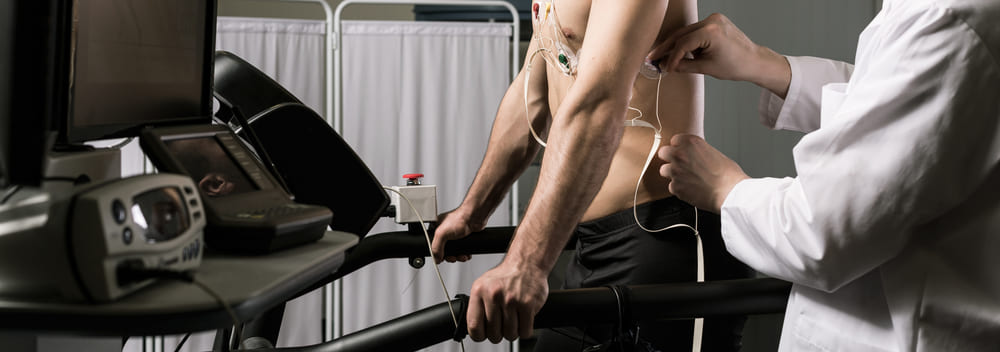What is the treadmill test procedure?
If you have experienced symptoms that may be related to heart disease, a treadmill test may be recommended by your doctor.
The treadmill test (TMT), also known as an exercise stress test, is a non-invasive diagnostic test that involves walking or running on a treadmill while your heart rate, blood pressure, and electrocardiogram (ECG) are monitored.
The test can help your doctor evaluate how well your heart and lungs are functioning, as well as identify potential risk factors for heart disease.
In this blog post, we will delve into the procedure and explore the different types of treadmill tests and their unique benefits.
By understanding the process and what happens during the test, you can prepare yourself mentally and emotionally. You’ll know what to expect in terms of the physical demands of the test, and how long the test will take.
Are there many different types of treadmill tests to know about?
According to Healthline, there are 3 types of stress tests used to evaluate the heart’s response to exercise. Here are the main differences:
1. Exercise stress test:
Also known generally as the basic treadmill stress test (TMT), it involves walking on a treadmill while the heart rate, blood pressure, and ECG are monitored.
The purpose of this test is to assess the heart’s response to exercise and to diagnose conditions such as coronary artery disease (CAD), heart rhythm abnormalities, and heart valve problems.
2. Nuclear stress test:
Also known as a myocardial perfusion imaging (MPI) test, it involves injecting a small amount of radioactive tracer into the bloodstream while the person is exercising on a treadmill. The tracer is taken up by the heart muscle, and a special camera is used to create images of the heart’s blood flow.
The purpose of this test is to evaluate the blood flow to the heart muscle and detect areas that may have reduced blood flow, indicating CAD or other heart problems.
3. Stress echocardiogram:
Also known as an echocardiography stress test, it involves using ultrasound imaging to create images of the heart while the person is exercising on a treadmill.
The purpose of this test is to evaluate the heart’s structure and function and to detect any abnormalities such as reduced blood flow, wall motion abnormalities, or valve problems.
Any special guidelines for those with chronic diseases?
If you have illnesses such as obesity, cholesterol, diabetes, and hypertension – or hereditary factors – they can all combine and have a multiplicative effect on the heart.
Let your doctor know about your ailments and your current management methods – like the advice you follow to reduce blood sugar levels, the high blood pressure treatment you have been given, the diet to lower cholesterol you’ve been prescribed, and your recommended obesity and weight management practices.
Your doctor will factor in your chronic ailments when planning your next steps, or even tell you if you aren’t advised to take a treadmill test at all.
What are the procedural steps for any treadmill test?
According to Mayo Clinic, the treadmill test is a cardiovascular endurance test performed on a treadmill by gradually increasing the speed and incline of the treadmill until you reach your maximal effort. Here are ten steps involved:
- You will be required to wear comfortable clothing and proper shoes for the test.
- Before the test, your blood pressure and heart rate will be measured, and a medical history will be taken to ensure that you are fit to perform the test.
- You will then be asked to step onto the treadmill, and the test administrator will set the initial speed and incline.
- The test will start with a warm-up phase where you have to walk at a comfortable pace for a few minutes.
- The speed and incline of the treadmill will then be gradually increased every few minutes, following a pre-determined protocol.
- Your heart rate, blood pressure, and oxygen consumption will be monitored throughout the test.
- You will be encouraged to continue the test until you reach your maximum effort or until you experience symptoms such as chest pain, shortness of breath, or dizziness.
- Your doctor will record your maximum heart rate, maximum blood pressure, and the level of exercise at which you reached your maximum effort.
- After the test, you will be asked to cool down by walking at a slower pace for a few minutes.
- Finally, your heart rate and blood pressure will be measured again to ensure they have returned to their pre-test levels.
What is the Bruce Protocol that doctors talk about?
According to Elizabeth Quinn, MS, writing in Very Well Fit, the “Bruce Protocol” is a standardized protocol for a graded exercise test used to assess cardiovascular health and fitness. The protocol involves increasing the workload by progressively increasing the speed and incline of a treadmill, following a pre-determined set of stages.
The Bruce Protocol consists of 7 stages, with each stage lasting for 3 minutes. The speed and incline of the treadmill are increased at each stage, according to a set protocol, as follows:
- Stage 1: 1.7 mph (2.7 km/h) at 10% incline
- Stage 2: 2.5 mph (4.0 km/h) at 12% incline
- Stage 3: 3.4 mph (5.5 km/h) at 14% incline
- Stage 4: 4.2 mph (6.8 km/h) at 16% incline
- Stage 5: 5.0 mph (8.0 km/h) at 18% incline
- Stage 6: 5.5 mph (8.8 km/h) at 20% incline
- Stage 7: 6.0 mph (9.7 km/h) at 22% incline
How long does a typical treadmill test usually take?
According to Cleveland Clinic, the duration of a treadmill test can vary depending on the specific protocol and your response to exercise. In general, a treadmill test can take anywhere between 15 to 45 minutes to complete, including the warm-up (2-3 minutes) and cool-down (2-3 minutes).
What else should I know about the treadmill test protocol?
Here are some additional things it’s good to know. Talk to your doctor about all these points. Being aware of all the angles can help reduce anxiety and improve your overall experience.
1. Preparation:
In preparation for your treadmill test, you may be asked to avoid eating or drinking anything except water for a few hours before the test. People with diabetes will be given special pre-test diet instructions according to their situation. You should also inform your healthcare provider of all other medications you are taking, as some medications can affect the results of the test. Some of these medications may be temporarily stopped for the test period.
2. Safety:
According to Stanford Health Care, while the treadmill test is generally safe, it involves physical exertion – and there is a small risk of complications such as heart attack, arrhythmia, or fainting. However, these risks are very rare and can be minimized by following the doctor’s instructions and guidelines.
3. Results:
After the test, your doctor will review the results and discuss them with you. Your treadmill test results may indicate your cardiovascular fitness level, the presence of heart disease, or other cardiac abnormalities. Further tests or treatments may be recommended based on the results.
In summary
Your heart is a precious and complex organ that plays a vital role in your overall health and well-being. By undergoing a treadmill test, you can help your doctor gain valuable insights into your heart, take steps to improve your cardiovascular fitness, and reduce your risk of heart disease. Stay heart-healthy. Be a Zinda Dil.
References
- Healthline. “Exercise Stress Test” Accessed: March 13, 2023. https://www.healthline.com/health/exercise-stress-test
- Mayo Clinic. “Stress test.” Accessed: March 13, 2023. https://www.mayoclinic.org/tests-procedures/stress-test/about/pac-20385234
- Quinn, Elizabeth, MS. Very Well Fit. “The Bruce Protocol Treadmill Test.” Accessed: March 13, 2023. https://www.verywellfit.com/the-bruce-treadmill-test-protocol-3120269
- Cleveland Clinic. “Exercise Stress Test.” Accessed: March 13, 2023. https://my.clevelandclinic.org/health/diagnostics/16984-exercise-stress-test
- Stanford Health Care. “Risks.” Accessed: March 13, 2023. https://stanfordhealthcare.org/medical-tests/s/stress-test/risks.html















